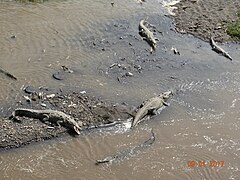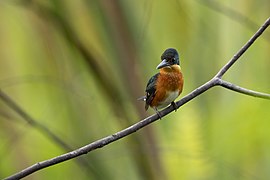Río Grande De Tárcoles
Course
The river's watershed drains approximately 67% of Costa Rica's untreated organic and industrial waste and is considered the most contaminated river basin in the country.
The river's upper reaches form the northern border of the Carara National Park. It is a habitat for American crocodiles, while the marshes located at the river's mouth have many waterfowl and wading birds. Among the many herons and egrets are the boatbill and bare-throated tiger heron, and other birds found here include double-striped thick-knee, mangrove warbler and American pygmy kingfisher. The total list known of birds well exceeds 320 species including the little known Guacalillo Canals. The avian biodiversity is substantial including rare birds such as Agami Heron, Rufous-necked Woodrail, Jabiru, Yellow-billed Cotinga and recently found an Orinoco Goose. It's also home of Howler and White-faced Capuchin Monkeys. Less commonly seen are Silky Anteater, Sloths, Grinson, Jaguarundi, River Otter and Northern Tamandua.
Reptiles, such as the American crocodile, caiman, common basilisk and large iguanas, are also easily seen.
-
Reptiles in the river
-
An American Pygmy Kingfisher
-
Royal terns
-
Snowy egret
References
- ^ Ballestero, Maureen (2003). "Tárcoles River Basin, Costa Rica: Background Paper" (PDF). worldbank.org.
- ^ Sebastian Rodriguez (1 March 2017). "Tárcoles: The most contaminated river in Central America". AIDA. Retrieved 2019-02-05.
- ^ "MBJ HOME". Mangrove Birding Journeys. Retrieved 2022-06-05.



